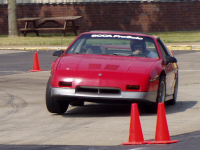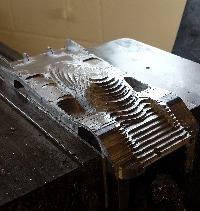Convert from Anilam Crusader M to EMC 2
- andypugh
-

- Offline
- Moderator
-

- Posts: 19731
- Thank you received: 4578
Not as far as I know.Ok. Does the 7i33 have that option as well?
or am I better off using a 3rd board dedicated to A/D for a high resolution conversion? It would work better, I think. The 7i87 is 12-bit and can plug into a 7i77. That gives you 8 +/- 10V inputs which sounds fairly well suited for reading tachometer inputs. That would measure as little as 2.4mV up to 10V, whereas the ones on the 7i77 board are 8-bits and so read from 13mV to 3.3V (and possibly not very well)
If the tachos are 3V / 1000rpm then the 7i87 will measure 0.8rpm to 3300rpm, whereas the 7i77 built-in Analogue will only be good for 4.3 rpm to 1100rpm.
Take advice from Pete / Mesa before buying though.
Please Log in or Create an account to join the conversation.
- andypugh
-

- Offline
- Moderator
-

- Posts: 19731
- Thank you received: 4578
Not as far as I know.Ok. Does the 7i33 have that option as well?
? It would work better, I think. The 7i87 is 12-bit and can plug into a 7i77. That gives you 8 +/- 10V inputs which sounds fairly well suited for reading tachometer inputs. That would measure as little as 2.4mV up to 10V, whereas the ones on the 7i77 board are 8-bits and so read from 13mV to 3.3V (and possibly not very well)or am I better off using a 3rd board dedicated to A/D for a high resolution conversion
If the tachos are 3V / 1000rpm then the 7i87 will measure 0.8rpm to 3300rpm, whereas the 7i77 built-in Analogue will only be good for 4.3 rpm to 1100rpm.
Take advice from Pete / Mesa before buying though.
Please Log in or Create an account to join the conversation.
- ryankracht
- Offline
- New Member
-

- Posts: 15
- Thank you received: 0
My goal during this upgrade will be to use all existing hardware. It appears that no-one has successfully done this, but I don't know why this shouldn't be possible. Anilam had a functional control after all. From reading other posts, my understanding is that drives get a tach feedback, and the motion controller gets (relatively low resolution) position feedback from "glass scales". I know of one successful Anilam to EMC via PPMC, although he had to add rotary encoders. I would like to avoid this, or at least understand why my current set-up won't work.
I am open to various motion control options at this point, my preference would go to whatever can drive my current hardware most efficiently for a reasonable cost.
Update on Progress:
- Confirmed function of all limit switches (single switch per axis--activated by dual fixed cams...one on each end of travel of the axis)...Done. E-stop will not reset if limit switch is tripped, system will e-stop if limit is reached while running.
- There is a spare terminal (P8) on the Anilam PCB 803 (see pic). If you bring pin 13 to gnd (pin14), the servos will enable upon e-stop reset. I wired in a momentary switch to this terminal so that I could keep my finger on a "deadman switch" while testing.
- Confirmed power up of all drives...done. There is no drift to the z axis, but some small very slow drift to the x and y.
- wired a 9V battery (see pic) to provide a 0 to ~3 V signal into the drives. To do this, I used pins 1-6 of the same terminal (P8) of PCB 803. I also needed to pull the connector from the Anilam control board that was outputting voltage. (PCB 502) Confirmed that I can drive both directions and stop. Done. Interesting that I can get rid of the small drift on x and y by applying a small control voltage. (seems like a good sign). I confirmed that positive voltage to the red wires give positive axis movement (from tool reference)
- checked tachs by measuring voltage across wires. I was surprised that this worked with the power off. I attempted to crank the axis as fast as I could, but I imagine that this is not as fast as they used to move when the controller worked. I measured about 5V max on the x and y, but saw up to 10V on the Z. The Z appears to have much more reduction, so I believe I could get the motor spinning faster with the mechanical advantage that I could use on that axiz. I am concerned that a 0-10V analog input is not a large enough range. I would not be surprised if the tach's output 0-15V like the signal input to the drives. If no 0-15V input is available, I will likely have to step down the voltage to make use of what is available. There is no convienent way to get this signal out as the tach's go directly into the drive. I needed to stick probe wires into the back of the connector to measure. TODO: confirm that the drive wasn't affecting this signal, unplug the connector and test again.
- I was surprised to see that with the axis moving in a positive direction (from tool reference) the tach sent a negative voltage.
Please Log in or Create an account to join the conversation.
- andypugh
-

- Offline
- Moderator
-

- Posts: 19731
- Thank you received: 4578
You probably need bipolar reading A to D to sense the two directions. the 7i87 is safe to 100V so it might well not matter if the speed input tops-out during fast moves. The suggestion to use the tachs is purely to aid tuning at very slow movement rates.- checked tachs by measuring voltage across wires. I was surprised that this worked with the power off. I attempted to crank the axis as fast as I could, but I imagine that this is not as fast as they used to move when the controller worked. I measured about 5V max on the x and y, but saw up to 10V on the Z. The Z appears to have much more reduction, so I believe I could get the motor spinning faster with the mechanical advantage that I could use on that axiz. I am concerned that a 0-10V analog input is not a large enough range. I would not be surprised if the tach's output 0-15V like the signal input to the drives. If no 0-15V input is available, I will likely have to step down the voltage to make use of what is available.
Normally the PID loop calculates its rate of change by differentiating encoder position counts, which for a relatively coarse feedback system like your glass scale may be rather noisy.
Wiring the tach signals to the pid.N.feedback-deriv pins gives the PID controller a much less noisy and more accurate velocity input.
Note that the inut to this pin is only used for the D-term of the PID, so you will not see any benefit from it with no Dgain.
Whether $99 for the 7i87 is worth the investment is a choice you need to make, but I think it should really help to reduce dither between scale counts.
Other conversions have tended to add encoders to the motors, but this is probably even more expensive.
I think that the encoder conversion bases P and D on the motor encoder and I on the scales.
The proposal here would be to base P and I on the scales and D on the tach/7i87.
But I am aware that I am performing a thought experiment with your money here.
This is a non-issue and can be solved in HAL.I was surprised to see that with the axis moving in a positive direction (from tool reference) the tach sent a negative voltage.
It is probably deliberate, the driver scheme is probably very simple, where the command voltage and tach voltage are summed, amplified and sent direct to the motors.
Please Log in or Create an account to join the conversation.
- PCW
-

- Online
- Moderator
-

- Posts: 17456
- Thank you received: 5093
As Andy mentioned, a negative tachometer reading in a positive direction is expected since the tachometer is negative feedback
(the negative tachometer output is summed with the positive command voltage when moving in a positive direction)
Its easy to extend the 7I87 input range (adding a 100K input resistor will increase the range to +-20V)
Please Log in or Create an account to join the conversation.
- andypugh
-

- Offline
- Moderator
-

- Posts: 19731
- Thank you received: 4578
I wonder if you could integrate tacho data and add it to the position, rather like the "position interpolated" in the software encoder?Even with ability to read the tachometer,you are still 'dead reckoning' between scale counts and with enough idle time you will drift until you hit a scale count
With some D-term shouldn't the drift be spotted and nulled?
Please Log in or Create an account to join the conversation.
- PCW
-

- Online
- Moderator
-

- Posts: 17456
- Thank you received: 5093
It may actually be that you dont care about the tachometer voltage above a volt or so, since you can use encoder velocity signals for interpolation when moving at any reasonable rate.
So maybe a +- 1V full scale range might be better (with some input clamping method)
All in all I wonder if adding a high resolution rotary encoder to the ballscrew end is not going to be better ultimate solution
Please Log in or Create an account to join the conversation.
- andypugh
-

- Offline
- Moderator
-

- Posts: 19731
- Thank you received: 4578
In practice 10um error in absolute machine position is pretty reasonable for a milling machine as long as it can avoid dithering between counts.
The tacho feedback ought to be able to help with the loose coupling problem, even if we don't know exactly how yet.
It might actually be a good plan to run two PID loops, a velocity loop controlling the motors with tachos as feedback, then a position loop using the scales as feedback and making velocity requests.
Please Log in or Create an account to join the conversation.
- Todd Zuercher
-

- Offline
- Platinum Member
-

- Posts: 4689
- Thank you received: 1433
Just the ponderings of a person who doesn't realy know what they are talking about.
Please Log in or Create an account to join the conversation.
- spangledboy
-

- Offline
- Senior Member
-

- Posts: 51
- Thank you received: 10
I can confirm that on my Crusader control the tach feedback only went to the drives. The encoders connected straight back to one of the Crusader boards while the analogue control signals came from a different board to the drives.
On careful inspection of the wiring schematic and detailed testing of what pin went where I managed to deduce that the majority of the pins on the massive round multi pin plug did nothing at all. One impressive looking 26 conductor ribbon cable in the control box turned out to only actually have 5 wires doing anything at all.
Please Log in or Create an account to join the conversation.
